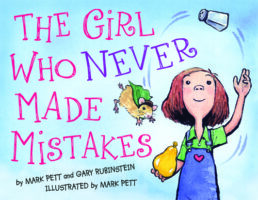SEL Read Aloud: The Girl Who Never Made Mistakes by Mark Pett and Gary Rubinstein

Summary
In “The Girl Who Never Made Mistakes” by Mark Pete and Gary Rubinstein, Beatrice wakes up on the day of the school talent show and completes her morning routine. She gets dressed, makes her bed, feeds her hamster, and packs lunch for her brother Carl. She remembers to do everything, and she does everything just right.
When Beatrice and Carl leave to go to school, she is greeted by fans who ask if she was able to maintain her perfect record this morning. Tonight she will perform her award-winning juggling routine. Most people call her “the Girl Who Never Makes Mistakes.” She could not be more different than Carl, who isn’t bothered by even the silliest mistakes.
At school, Beatrice nearly drops four eggs during a cooking activity, and she can’t stop thinking about it. Later, she refuses to join two friends who are struggling to ice skate. At dinner, she tells her dad she is worried about making a mistake at the talent show.
That night, Beatrice juggles her pet hamster, a salt shaker, and a water balloon. Everything is going well, until she notices she grabbed accidentally grabbed the pepper shaker instead. The pepper causes her hamster to sneeze and grab and pop the water balloon, ruining the performance.
Both she and the audience are stunned, until she starts laughing and the audience joins along.
The next day, her fans are all gone. She decides to do things differently. She even tries ice skating. Things are messier and sillier, but more fun. People start calling her Beatrice.
Comprehension Questions
Six questions aligned to Bloom’s taxonomy for teacher’s to evaluate students’ comprehension
- Remembering: What is the name of Beatrice’s hamster?
- Understanding: What led to Beatrice’s first mistake during the talent show?
- Applying: How might Beatrice’s approach to daily activities change after making her first mistake?
- Analyzing: Analyze the reaction of the audience to Beatrice’s mistake. What does this reveal about their expectations and their response to imperfection?
- Evaluating: Do you think it’s realistic for someone to never make mistakes? Why or why not?
- Creating: Design an alternative ending where Beatrice embraces her ability to make mistakes earlier in the story.
CASEL Discussion Questions
Five questions aligned to the CASEL competencies for teachers to foster an engaging discussion and foster social-emotional learning
- Self-Awareness: Beatrice was known as “the girl who never made mistakes.” How do you think this label influenced her self-awareness and the pressure she put on herself?
- Self-Management: Beatrice was very nervous before the talent show. Discuss strategies she could have used to manage her anxiety and fear of making mistakes.
- Social Awareness: Discuss how Beatrice’s mistake and her reaction to it might have changed her peers’ perceptions of her. How does social awareness play a role in understanding and empathizing with others’ experiences of failure and success?
- Relationship Skills: Beatrice’s brother, Carl, loves making mistakes. How does his attitude toward mistakes influence Beatrice? Discuss how different perspectives in relationships can lead to personal growth.
- Responsible Decision Making: Beatrice decides to laugh instead of running away or crying after her mistake. Discuss how this decision impacted her and those around her. How does responsible decision-making affect our outcomes and relationships?
Design Thinking Challenge
Take students’ learning even further by incorporating the Imagineerz design thinking framework
Create a bravery badge
Understand
- Begin with a class discussion on “The Girl Who Never Made Mistakes” and Beatrice’s journey from perfection to embracing imperfections. Discuss the emotions and pressures Beatrice experienced and how they changed over the course of the story. Ask students to reflect on times they were afraid to make mistakes and how overcoming those fears felt.
Ideate
- Encourage students to brainstorm ideas for a bravery badge that someone could wear or display after facing a fear or overcoming a challenge related to making mistakes. Discuss what symbols, colors, or words could represent bravery, growth, and the acceptance of imperfection. How can a badge remind us that it’s okay to make mistakes and that bravery is in trying?
Prototype
- Students will design and create their bravery badge using classroom materials such as paper, fabric scraps, markers, stickers, and recyclable items. Encourage them to incorporate elements that symbolize personal growth, such as a butterfly for transformation or a rising sun for a new beginning. The badge should be something tangible that reflects the story’s themes and personal experiences with bravery.
Test
- Have students present their bravery badge, sharing the story behind its design and what personal or fictional challenge it represents. They should explain how this badge could help someone like Beatrice feel proud of their bravery and more comfortable with the idea of making mistakes.
- Collect feedback on the designs, focusing on how well the badges symbolize bravery and growth, and how they might encourage others to embrace their imperfections. Discuss how wearing or displaying such a badge could influence a person’s mindset towards challenges and mistakes, fostering a supportive community where growth is celebrated.
Read Aloud
If you appreciated getting to read this book with your class, you might also want to share this book with them!
Additional Resources
Copyright Notice
The image on this page comes from the book The Girl Who Never Made Mistakes by Mark Pett and Gary Rubinstein. Copyright © 2011 by Mark Pett and Gary Rubinstein.


